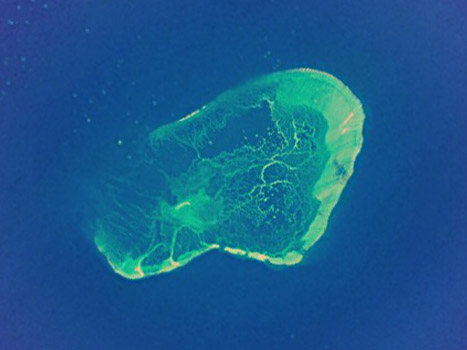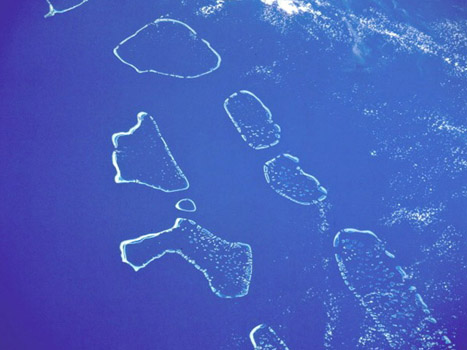| Oceans |
| The oceans cover 77% of the Earth's surface
and give "the blue planet" its dominant colour. Sediments accumulate at
the edges of the continents on the continental shelf and around mid-ocean
islands, brought to the ocean by river waters. The continental shelf off
the Atlantic coast of North America consists of a pile of sediments several
kilometres thick, topped by 3 metres of sand which continue to be moved
around by ocean tides and currents. Tides are caused by the gravitational
attraction of the Moon. Surface currents are largely driven by pressure
and wind systems in the atmosphere above.
Mud and sandbanks are exposed at low tide in the Fresian Islands.
Wave action can shift coastal sediment into sandbars and spits. Large slumps of sand or mud can give rise to turbidity currents which move very fast down slight slopes due to the increased density of water containing suspended material. Deep gullies and canyons have been eroded on the sea bed, particularly in the continental shelf sediments.
Deep canyons in the continental shelf of Monterey Bay, California. Sediments also accumulate right across the ocean basins from the chemical deposition of dissolved minerals. The calcium carbonate shells of dead sea creatures sink and accumulate as oozes on the deep ocean floor. In contrast to the canyons of the continental shelf, the deep ocean floors are the flattest places on the planet. The mid-ocean ridges are where new Earth crust is created by the extrusion of lava at tectonic plate boundaries. Like the atmosphere, the oceans are responsible for heat flow from the equatorial regions to the poles. This spreads energy from the sun over the surface of the planet, evening out extremes of climate. Similar to the Hadley circulation cells in the atmosphere, a global circulation system has been suggested for the oceans, whereby warm waters are carried poleward at the surface, and returned as cold, dense water in the ocean depths. This "great ocean conveyor belt", with a turnover period of more than 1,000 years, is a key part of the global climate system. Unlike the atmosphere, ocean circulation is restricted by the position of the continental landmasess, with exchanges of water between the ocean basins being quite limited.
Global sea surface temperatures over a ten-day period.
Some ocean lifeforms secrete calcium carbonate shells to protect themselves as they move through the water. Others anchor themselves to rocks in shallow seas, leaving behind their "skeleton" calcium carbonate as a coral reef structure when they die. Coral reefs are found on carbonate platforms in shallow water on the continental shelf and in mid-ocean. Mid-ocean coral reefs initially grow in the shallow water around a volcanic island. As volcanic activity ceases, the island starts to erode and subside, but the coral colonies continue to grow if they stay within the sunlit top 20 metres (37 feet) of the ocean. In this way, circular atolls are formed, with great thicknesses of limestone above the sites of extinct volcanoes.
Pearl and Hermes Atoll, part of the Hawaiian chain in the Pacific.
The Maldive Islands, a string of more than 2000 coral formations. |
| Links | ||||||
|






